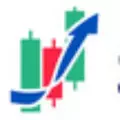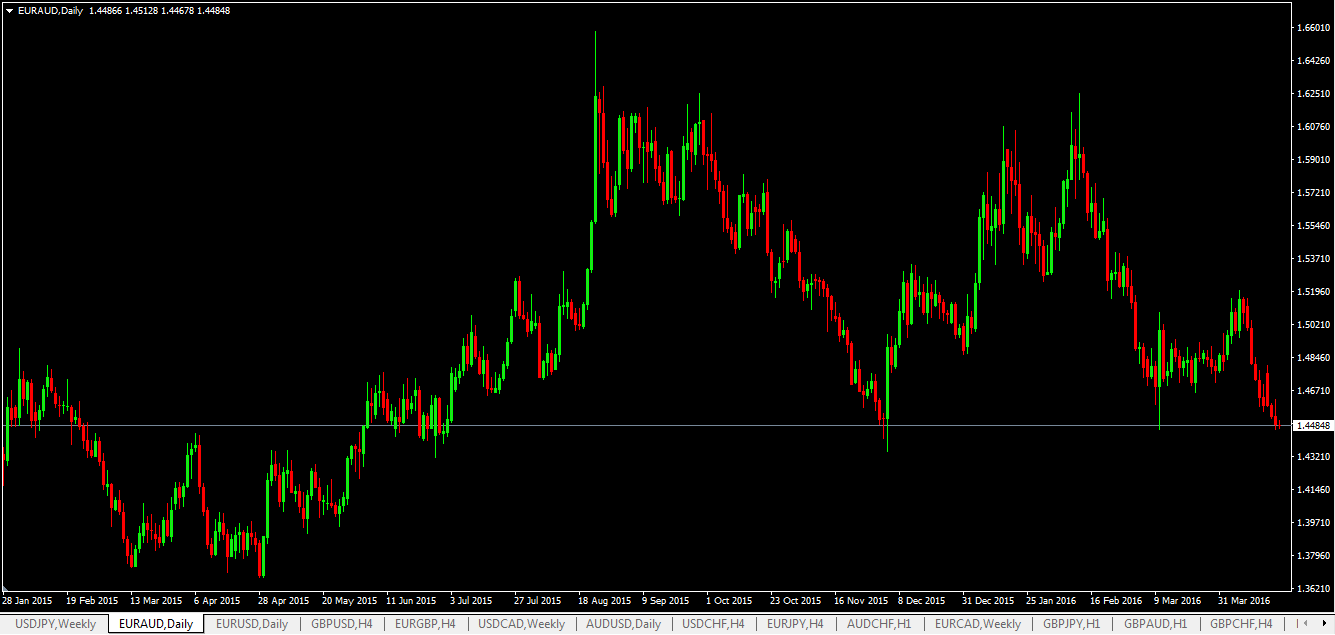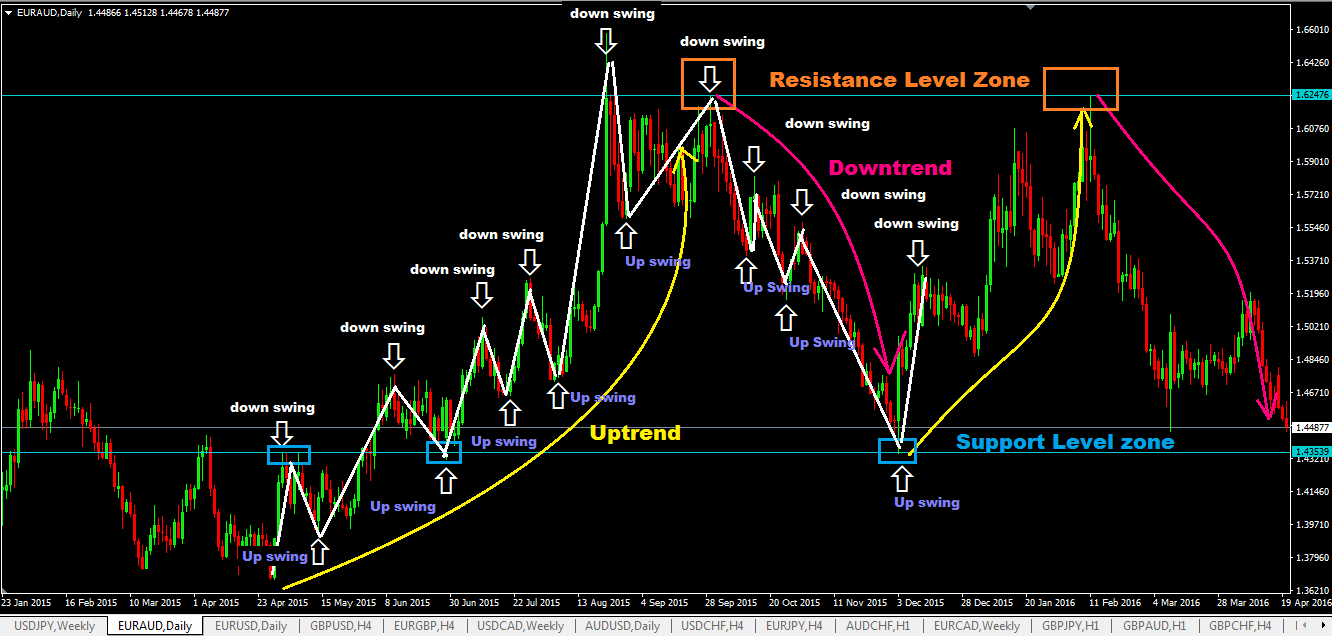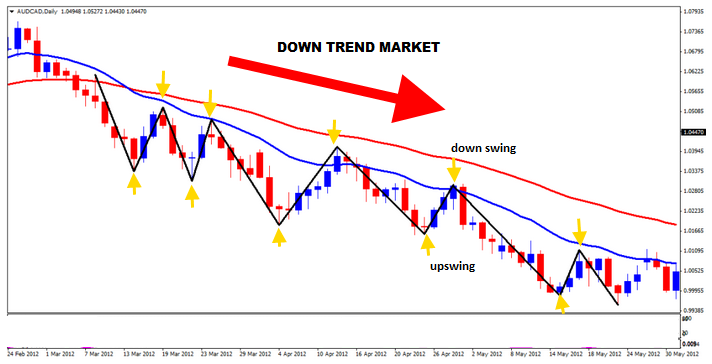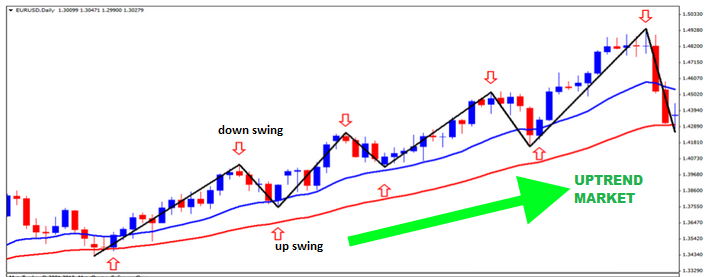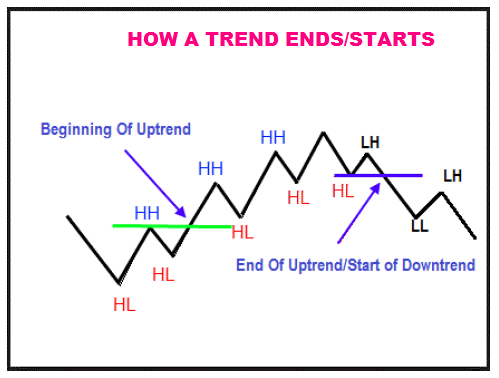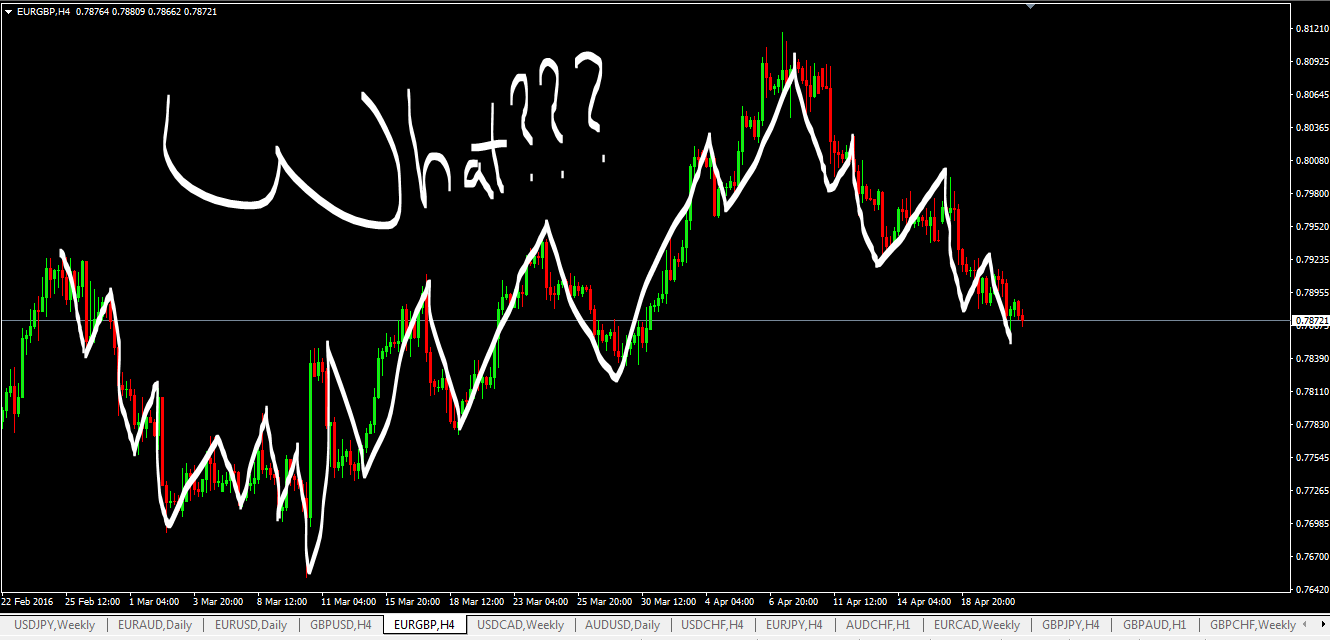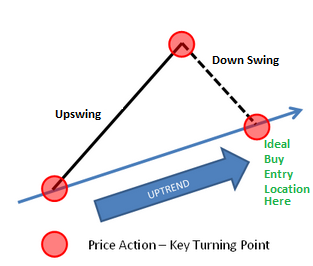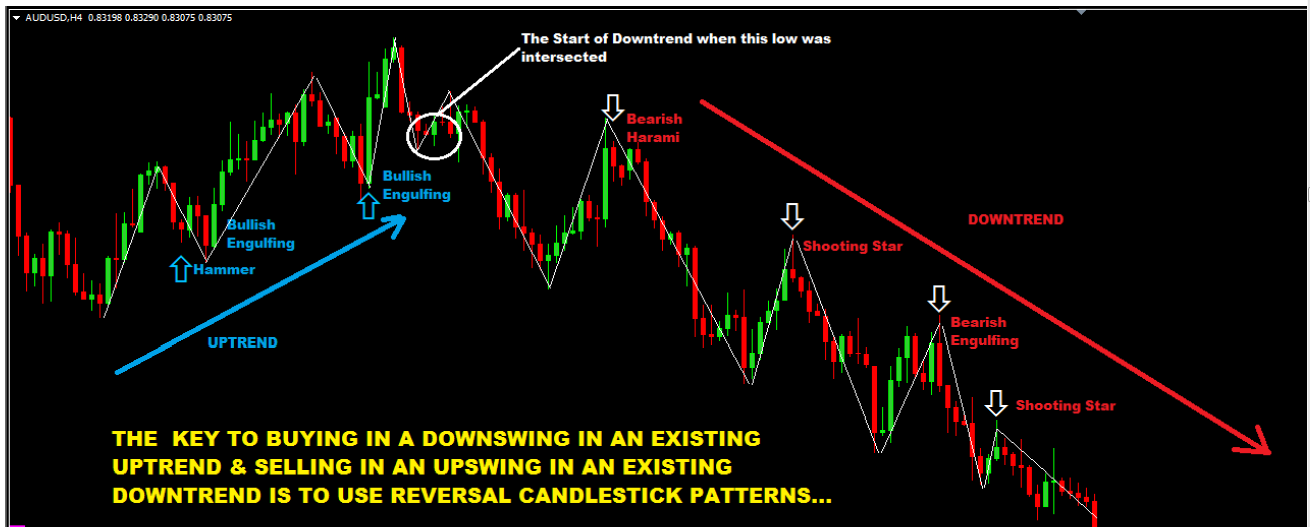But to a swing trader, this chart tells a lot more things than what the untrained eye can see, things like:
- a swing trader can easily identify the past and current trend on the chart and know if the structure of the trend is intact or not or if the trend can potentially change because the structure is broken
- a swing trader can easily identify the past price upswings and downswings and these can either form support and resistance levels that price can bounce up or down from sometime in the future.
- a swing trader can easily identify the major support and resistance levels
- the trader can identify swing trading opportunities
This EURAUD daily chart below is the same chart as above and shows how the price moved.
And when a swing trader looks at this chart, this is what he sees instantly:
Why Trend Identification Is Important To A Swing Trader
To a swing trader, trading with the trend is really important because in a trend, there are two things that a swing trader looks for:
- to see if the trend is still intact or is the trend about to change or showing signs of changing
and then once trend identification and analysis are complete, the next thing a swing trader does is zoom in closer and look that the up swings and down swings of the trend.
Looking closer at the upswings and downswings of price in a trend allows swing traders to get the best trade entries with really good risk:reward ratios.
This post will help you identify price trends.
What Is A Down Swing and Up Swing Pattern In A Trend?
These two charts below will explain the concept of downswings and upswings in a trend very clearly…
This first chart shows AUDCAD on the daily time frame in a downtrend market. You will notice the price patterns of upswings and downswings as the price continues to go lower and lower.
A similar but opposite situation happens in an uptrend market as shown by this EURUSD daily chart below:
These upswings and downswings of price are like the waves in a trend:
- in an uptrend, the peaks and troughs of these upswings and downswings are increasing.
- in a downtrend, they are decreasing.
So in an uptrend market, price makes increasing higher highs and increasing lower lows. So here are some important points for you to remember in swing trading.
- the downswing in an uptrend happens when the price makes a higher high (HH) and moves down to a higher low (HL).
- So that whole distance between the formation of HH and HL is a downswing…it is not just one point.

Similarly, in a downtrend or bear market:
- the downswing happens when price makes a lower high (LH) and moves down to a higher lower low (HL).
- So that whole distance between the formation of LH and LL is a downswing…it is not just one point.

Once you begin to understand these concepts mentioned above, you will see and understand how trends end or start. This is a very important trading concept.
How Do Trends Start/End?
For many swing traders, price action leaves clues as to when a trend may be starting or ending.
Now you can see how the concept of upswings and downswings that you’ve just read above are going to make sense here when it comes to trend identification in swing trading.
When using price action only to identify trend start and end, the following two are really important concepts that every forex trader should know like the 10 commandments, except you only have to remember only 2 laws:
- An uptrend is said to begin when the Higher High is intersected and price closes above it.
- A downtrend begins when the Lower High is formed and the higher low (HL) is intersected.
This chart shows you what we mean:
The chart above is a textbook example. (It’s perfect in every way, in an ideal situation).
The reality of forex trading is more like this:
:
As you can see on the chart above, it does look kinda confusing…and to be quite honest, it would be because there are always going to be a few false “trend changes” signals before the trend actually changes.
There’s no way you can solve the problem That’s just the way this forex market works.
You just have to learn to take it as it comes.
One solution is to really spend a lot of time looking at charts and understanding how price moves and price action. This way you can improve your swing trading.
How To Enter A Swing Trade
It is generally accepted that: swing traders like to enter trades at really low-risk, high-reward entry points. this is one of the reasons that makes swing trading so attractive.
In an ideal situation, a swing trader would enter a trade in an uptrend market just when the downswing is ending so he can profit in the uptrend move on to the next upswing.
Similarly, in a down-trending market, the swing trader would enter a trade just when the upswing is ending so that on the next downswing, he can profit quickly as the price moves down.
The chart below shows an example of a market in an uptrend and price doing its upswings and downswings. The very point where the downswing ends is the best buying entry point for a swing trader:
The key to buying in a downswing in an existing uptrend and selling in an upswing in an existing downtrend is to use reversal candlestick patterns.
Learning these reversal patterns will give you the best entries in swing trading. You can have trades that have a 1:10 risk: reward ratio or more. Start by going through your charts and backtesting areas where you could have jumped on to a swing trade. Calculate the probable risk-reward ratio of those trades and you will begin to appreciate how powerful these good entries can be.
Advantages of Swing Trading
- with swing trading, it is easy to manage take profits and stop losses because you can actually place your stop loss a bit further away from the market price to avoid getting stopped out prematurely and also your take profit targets a place a bit further away so that your risk to reward ratio are 1:2 or higher.
- swing trading is much easier to learn and do than day trading
- trading transaction costs due to spread are much lower than that of day trading because of fewer trades placed.
- you have a lot more time to analyse trades and then take trades and therefore swing trading can suit someone who has a day job.
- swing trading does not take a lot of your time…you can place your trade and walk away instead of babysitting your trade like in day trading.
- Swing trading is much less stressful than day trading.
- Profits made are much larger than in day trading because you let your trades run for more than 1 day so the chance of increased profit is much greater than in day trading.
- Swing trading allows swing traders to ride out the trend for maximum profit extraction using this best trailing stop technique
Disadvantages of Swing Trading
- Some forex traders can find swing trading difficult to learn and do or it may not fit the trading personality of the trader.
- swing trading can be time-consuming especially when you are analyzing your trade setups and you have to wait a long while before your trading setups happen so that you can take your trade.
- swing trading is not a set-and-forget system, you have to monitor your trades daily to move stop loss to break even, move trailing stop etc.
- a swing trader can get so attached to a trade because he may be in that trade for a while and instead of exiting and taking profits, his attachment can cloud his judgment
- As in day trading, trading discipline and risk management as well as keeping emotions in check are very important. It is not uncommon for swing traders to exit on a retrace or trend change only to have the market immediately change back and head in the original direction
Price Action Trading and Swing Trading
Price action trading complements swing trading because price action helps you in finding better trade entries.
Price action trading leaves you clues like bearish and bullish reversal candlesticks which can be used as your sell and buy signals. You can even see these swings and clues on a synthetic indices chart
Here’s how:
- in an uptrend, when you see a bullish reversal candlestick in a downswing, it can be used as a buy signal. These are the type of bullish reversal candlesticks you should be looking for:
- in a downtrend, when you see a bearish reversal candlestick in an upswing, it can be used as a sell signal. These are the types of bearish reversal candlesticks you should be looking for:
So make sure that you go through this free price action trading course and use it with swing trading.
